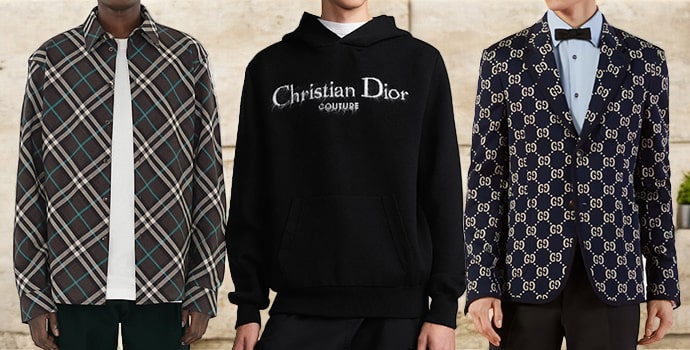Recognizing Apparel: The Relevance of Material Selections in Your Wardrobe
The selection of fabric in apparel plays a crucial duty in both aesthetic appeals and performance. Different materials use varying levels of comfort, breathability, and toughness, directly affecting the user's experience. Understanding these subtleties can improve one's wardrobe significantly. Yet, numerous forget just how these choices can impact not simply individual design, however likewise sustainability. What textile decisions could redefine your closet and straighten it with both design and responsibility?
The Duty of Fabric in Style and Performance

Typical Textile Kinds and Their Qualities
When selecting apparel, recognizing the features of typical material kinds is vital for making educated choices. Cotton, a widely-used natural fiber, is known for its adaptability, breathability, and softness, making it ideal for sportswear and day-to-day garments. Bed linen, an additional all-natural choice, boasts outstanding moisture-wicking buildings and a distinctive appearance, suitable for cozy climates.Wool, often preferred for its heat and toughness, varies in excellence; merino wool is soft versus the skin, while coarser kinds are used for outerwear. Artificial textiles like polyester and nylon use longevity and resistance to creases, making them popular for activewear and travel garments. Blends, which incorporate artificial and all-natural fibers, can improve performance while maintaining comfort. By acknowledging these textile features, individuals can choose clothes that aligns with their way of life and aesthetic choices.
Breathability and Comfort: Picking the Right Fabrics for Various Climates
Choosing the appropriate fabrics for different environments can substantially boost comfort and total wearability. Breathable products are essential in hot climates, as they permit air circulation and wetness evaporation. Fabrics such as cotton, bed linen, and moisture-wicking synthetics effectively draw sweat away from the body, maintaining the wearer cool and completely dry. Conversely, in cooler climates, thicker textiles like wool or fleece supply insulation while maintaining breathability, making certain warmth without overheating.Additionally, the choice of textile weight plays an essential function; light-weight fabrics are preferable for summertime, whereas heavier options are fit for winter months wear. Comprehending the one-of-a-kind residential or commercial properties of each textile enables individuals to dress properly for differing weather. Eventually, selecting breathable and comfortable materials tailored to certain climates can significantly improve day-to-day comfort and improve the general experience of wearing apparel.
Sturdiness and Treatment: Just How Material Affects Long Life of Your Wardrobe
Selecting the appropriate materials can greatly affect the longevity and care needs of a wardrobe. Fabrics such as cotton and polyester are known for their durability and simplicity of upkeep, making them suitable for daily wear. On the other hand, delicate products like silk and lace require more careful handling and specialized cleaning techniques, which can increase the moment and effort required for care. Branded Clothing.Durability is also affected by the material's weave and finish; firmly woven fabrics tend to stand up to damage far better than freely woven alternatives. Furthermore, artificial blends typically give boosted durability, combining the very best top qualities of multiple fibers.Understanding the treatment directions for every fabric is necessary, as incorrect drying out or cleaning can lead to premature wear. Ultimately, selecting sturdy products can cause a longer-lasting closet, reducing the regularity of replacements and contributing to an extra lasting fashion selection
The Impact of Fabric on Fit and Shape

Lasting Material Choices: Making Eco-Friendly Choices
The influence of fabric extends beyond fit and silhouette to incorporate environmental aspects, prompting an expanding passion in lasting fabric options. Eco-friendly fabrics, such as natural cotton, hemp, and Tencel, are getting grip amongst customers who prioritize sustainability in their wardrobes. These products are commonly generated with less chemicals and water, decreasing their ecological footprint.Additionally, recycled textiles, made from post-consumer waste, provide an innovative remedy to the fabric market's contamination problem. Brands progressively accept openness in their sourcing methods, enabling consumers to make informed decisions about their purchases.Choosing sustainable materials not only sustains honest practices yet also urges the fashion industry to adopt even more accountable manufacturing techniques. As understanding of environmental concerns increases, people are prompted to assess the long-lasting effect of their textile selections, fostering a movement in the direction of an extra sustainable and eco conscious technique to style.
Raising Style: Exactly How Textile Can Change a Clothing
While lots of might concentrate on color and cut when choosing an attire, the choice of material plays an important duty in raising style and boosting general appearance. Different materials share unique state of minds and messages; for example, silk radiates high-end and elegance, while jeans provides an informal, kicked back ambiance. The texture and drape of a Resources fabric can substantially change the silhouette, with organized materials giving a refined appearance and softer ones developing an extra fluid, relaxed aesthetic.Moreover, the weight of the material influences wearability across periods. Light-weight fabrics like bed linen and cotton are excellent for summer, while heavier materials such as wool and velour provide heat and style in colder months. Comprehending textile homes, such as breathability and stretch, also empowers people to make enlightened selections that boost convenience without compromising design. Ultimately, the best textile can change an attire from normal to phenomenal, making it an important consideration in any type of wardrobe.
Regularly Asked Questions
How Do I Identify the Fabric Content of My Clothes?
To determine material material, one can take a look at treatment labels, conduct shed examinations for fiber identification, or speak with textile swatches. These methods assist separate products, ensuring notified options for garments care and upkeep in day-to-day wear.
Can Fabric Choice Affect My Mood or Confidence?
Fabric selection can significantly impact an individual's mood and confidence. Branded Clothing. Certain products might evoke feelings of convenience or style, while others can really feel unflattering or restrictive, inevitably affecting self-perception and psychological wellness throughout the day
What Fabrics Are Ideal for Delicate Skin?
For individuals with delicate skin, all-natural fabrics like bamboo, bed linen, and cotton are commonly recommended. These products are breathable, hypoallergenic, and less likely to trigger irritability, making them ideal options for comfort and skin health and wellness.
How Do I Effectively Laundry and Look After Different Fabrics?
To properly clean and care for various textiles, one have to think about each material's details demands, including temperature settings, cleaning agents, and drying out techniques, ensuring durability and preserving the fabric's initial top qualities for optimal usage.
Exist Particular Fabrics for Athletic or Performance Put On?
Athletic or performance wear frequently uses click here for more info materials such as polyester, spandex, and nylon. These materials are designed for moisture-wicking, breathability, and versatility, boosting movement and convenience throughout exercises while providing longevity and support. On the other hand, in colder climates, thicker materials like wool or fleece supply insulation while maintaining breathability, making sure heat without overheating.Additionally, the selection of material weight plays an essential role; lightweight fabrics are more effective for summertime, whereas larger options are suited for winter months wear. In comparison, delicate products like silk and shoelace call for even more careful handling and specialized cleansing methods, which can increase the time and initiative needed for care.Durability is additionally affected by the fabric's weave and finish; securely woven fabrics tend to withstand wear and tear much better than freely woven alternatives. In comparison, stiff fabrics can restrict motion yet provide a traditional, polished look.Moreover, the thickness and texture of the textile can influence the aesthetic perception of body form. The influence of textile prolongs past fit and shape to encompass environmental aspects, prompting an expanding interest in sustainable fabric selections. The texture and drape of a textile can dramatically change the silhouette, with organized materials offering a polished appearance and softer ones producing an extra fluid, relaxed aesthetic.Moreover, the weight of the fabric affects wearability across seasons.